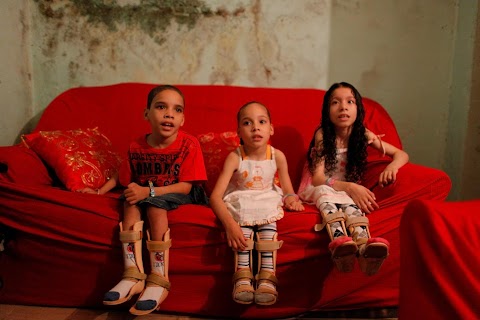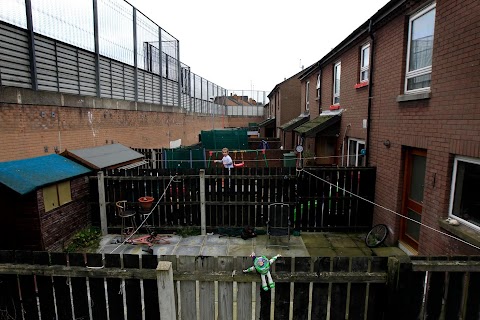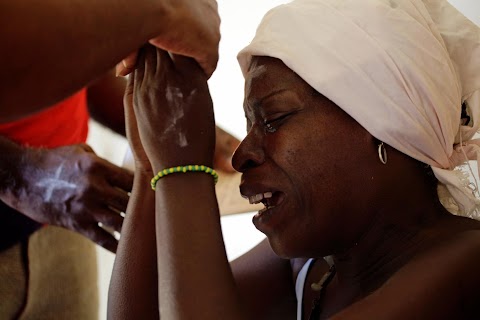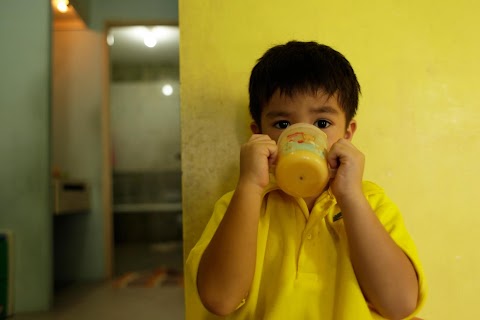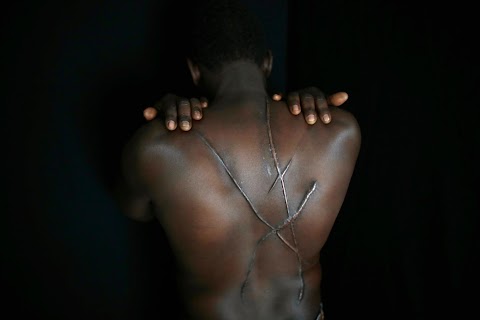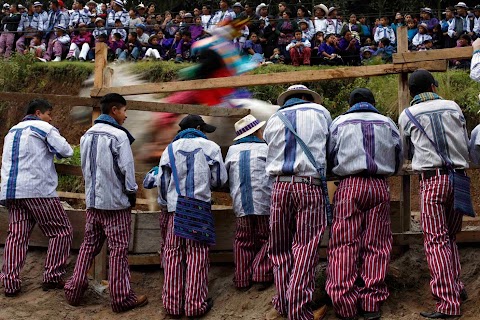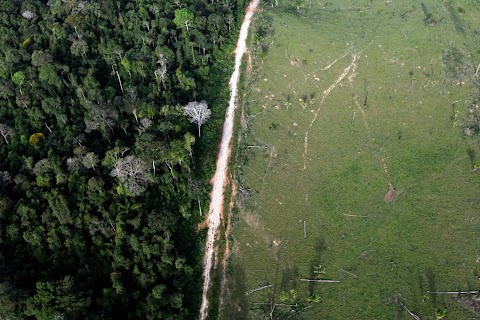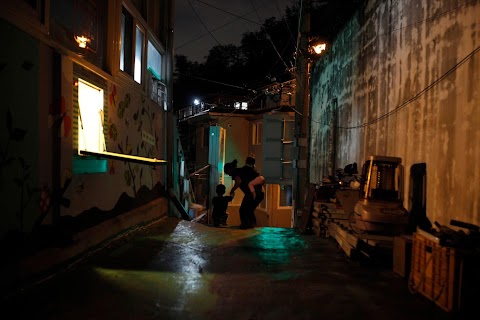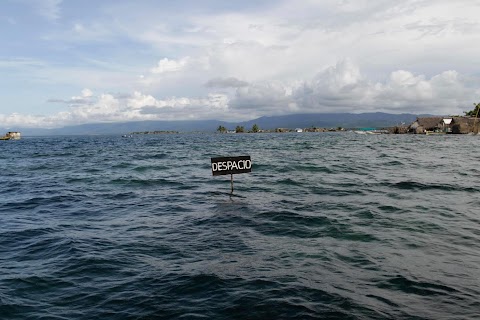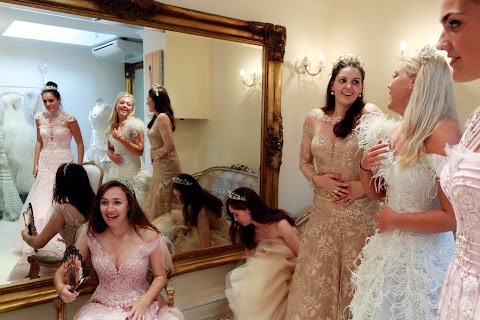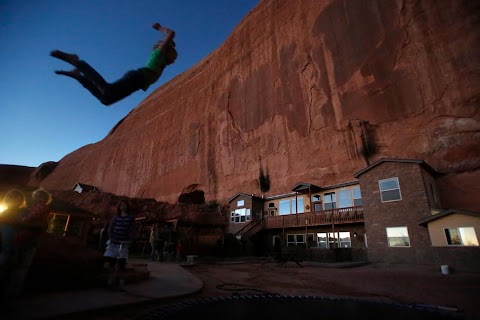
Portraying polygamy
 Jim Urquhart
Jim Urquhart
This girl playing on a trampoline is one of the roughly 100 residents of the “Rock” - a community of fundamentalist Mormons living in homes embedded deep into a towering sandstone precipice in Utah.
Their houses are not the only unusual aspect of their lives. Several of the 15 or so families who live here also practice polygamy, believing that plural marriage brings exaltation in heaven.

Polygamy was part of the teachings brought to Utah by faithful Mormons in the late 1840s, but it was abandoned by the mainstream Mormon Church around 50 years later. Nevertheless an estimated 37,000 Mormon fundamentalists continue the practice today.
Enoch Foster is one of them. In this shot he prepares dinner with his first wife Catrina Foster and their one-year-old daughter Evangelina, one of his 13 children from two wives.
Slideshow

Anna Knecht, a fundamentalist Mormon who is monogamous, tends to her newborn daughter Evahny Knecht.

Enoch Foster, a fundamentalist Mormon with two wives, walks with his first wife Catrina Foster and several of his 13 children.

Residents from the “Rock,” as they call the area where they live, harvest the community garden along with their children.

Suzanne Morrison, a polygamous fundamentalist Mormon, sorts potatoes from the community garden with her two-year-old daughter Eve.

Moroni Foster, 13, who is from a polygamous family, holds a beet he collected from the community garden.

Abel Morrison, who practices polygamy, tends to a community garden with several of his children.

The houses where the community lives are made by blasting holes into the sandstone rock, which in some places is 400 feet tall.

Bradee Barlow, who lives in a polygamous marriage, holds her newborn daughter Lucy while she shops at the store room.

Enoch Foster walks into the community's Charity House with his first wife Catrina and some of his children.

Catrina Foster, who also has a polygamous marriage, brushes her nine-year-old daughter Christa’s hair.

Enoch Foster sits with some of his children.

Enoch Foster prays before a meal with his first wife Catrina Foster, second from left, and several of his 13 children.

A bible verse hangs on the wall as Enoch Foster eats dinner.
"Yes, they lived in the side of a rock formation, but they had all the trappings of the modern world."
Growing up in Utah, a knowledge of polygamy has long been part of my experience. I can recall standing on the side of the residential road looking at a nondescript home with a large cinder block wall surrounding it. My friend leaned over to me to tell me that a polygamist family lived there.
He tried to explain to me what plural marriage was in the best way a 10 year old can. I was confused. It wasn’t until I was older that I began to grasp the concept of what polygamy was. But, until recently, it was a skewed and unfair view.
Then the reporter Jennifer Dobner introduced me to the "Rock.” Formally known as Rockland Ranch, it’s a community of approximately 15 families, both polygamous and monogamous, living near the southern tip of Canyonlands National Park, in one of the most beautiful settings in the world.
The community of about 100 people was founded some 35 years ago on the south face of a sandstone rock which, in places, is 400 feet tall. They live in homes - many measuring more than 5,000 square feet - made by blasting out of the sandstone with explosives, then filling the spaces with the fixtures of modern living: electricity, internet, running water and more.
Fundamentalist Mormons make up the majority of the Rock community. Although the modern Mormon Church abandoned the practice of polygamy in 1890, an estimated 37,000 fundamentalists still practice polygamy and believe it brings exaltation in heaven, as the church originally taught.
This was my first look inside a community like this and any preconceptions were totally blown away. I found people like Enoch and Catrina Foster who were raising 13 children with another wife. There were no prairie dresses to be found. There was not a culture of women and children being oppressed. I found children being educated and women running the households with a sense of command. The community members were not cut off from society. Many work in the nearby town of Moab, Utah, and are very successful.
We were welcomed in and allowed to have frank conversations. There was no filter. Quite frankly, the people were no different to anyone else I know. Most of the adults were about my age (mid-30’s) and were open minded and educated. They never pushed religion and are active members of society.
It was an almost ideal setting to raise a family. Yes, they lived in the side of a rock formation, but they had all the trappings of the modern world. The location on the edge of the wilderness provided children with a safe environment to thrive in and explore. I did not see one wasting the day playing on a video game console.
Neighbours knew each other and watched out for each other. While many can go out and into town and enjoy a drink with dinner, alcohol and drugs were not in the settlement. The residents relied on one another to participate and provide labour to maintain the community.
I was moved when Enoch extended an invitation for me to come back and hang out anytime as a friend. Enoch and Catrina were so open with us and we were able to have honest discussions about concepts like humility and about what is most important to us – such as our families.
